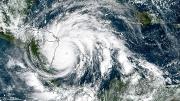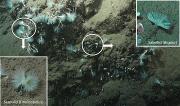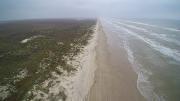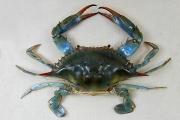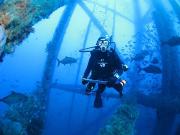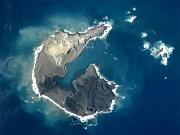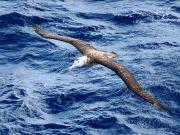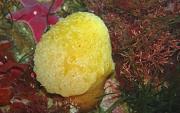Radio Program
Our regular Science and the SeaTM radio program presents marine science topics in an engaging two-minute story format. Our script writers gather ideas for the radio program from the University of Texas Marine Science Institute's researchers and from our very popular college class, Introduction to Oceanography, which we teach to hundreds of non-science majors at The University of Texas at Austin every year. Our radio programs are distributed at to commercial and public radio stations across the country.
The 2020 hurricane season was a mean one. It produced 30 named storms, which was a new record. Thirteen of the storms became hurricanes, which was tied for the second most on record. A dozen storms hit the United States -- another record. And combined, the storms produced an estimated 37 billion dollars in damages.
Some small worms may be doing the world a big favor. They’re gobbling up bacteria that eat methane, a gas that contributes to global warming.
Biologists discovered the worms during research cruises in 2017 and ’18. The scientists were studying the ocean floor off the Pacific coast of Costa Rica. In particular, they were using a small robotic submarine to scan the area around methane seeps -- spots where methane is bubbling up into the water from underground pockets.
Padre Island is perhaps best known for its visitors: spring breakers in March and April, endangered sea turtles during summer, and migrating birds in the winter. And there’s plenty of room for them, because Padre is the longest barrier island in the world.
Barrier islands form as waves and currents drive sand from the ocean floor toward land. Eventually, enough sand piles up to rise above the water. Such islands protect the coastline from tropical storms and other threats.
Blue crabs are among the most popular seafood items in the country. Tens of millions of them are harvested from bays and estuaries every year. They account for thousands of jobs and hundreds of millions of dollars in sales -- all for a little critter that’s more legs and shell than meat.
Blue crabs are found along the Atlantic and Gulf coasts. They’re most common in Chesapeake Bay, where a 2020 census found more than 400 million of them. That was down from the year before, but well within the range needed to keep the population healthy.
In the darkness of the deep ocean, the faintest glimmer of light can mean the difference between life and death. It can scare away prey or draw in predators. So remaining completely dark can help a deep-sea fish catch a meal -- or avoid getting caught.
A recent study found some fish that have a big advantage in that area. Their skin is almost completely black -- it reflects no more than one-half of one percent of the light that strikes it. That makes the fish much darker than charcoal, and among the darkest living organisms on the planet.
Setting up an offshore oil rig takes a lot of time and money, and a lot of thought about the environment. And so does taking one down. California, for example, is pondering what to do with a couple of dozen platforms that have shut down or that are about to. And researchers have looked at what might happen to fish around those rigs.
Offshore platforms make good reefs. Mussels, oysters, and other shellfish latch on to the structure. Dead shells fall around the rig, providing good hiding places for small fish and other critters. That attracts larger fish.
A volcanic island in the western Pacific Ocean just can’t settle down. After not changing much for thousands of years, it’s undergone a series of eruptions in recent decades. That’s made it much bigger. And the eruptions may not be done.
Nishino-shima is about 600 miles south-southeast of Tokyo. It’s the tip of a volcano that rises two miles from the ocean floor.
The Tristan albatross is one of the largest sea birds on the planet. It has a 10-foot wingspan, which it uses to soar across millions of square miles of the Atlantic and Indian Oceans. But the albatross nests mainly on one small island in the South Atlantic -- and that’s been a big problem. House mice introduced to the island a century and a half ago are eating the eggs and chicks, and even attacking adults. That’s made the Tristan albatross a critically endangered species.
The striated frogfish has quite a resumé. It walks on the ocean floor, camouflages itself to avoid predators, carries its own fishing lure, and can gobble another fish faster than the blink of an eye. And it has a shaggy appearance that’s earned it a nickname: the hairy frogfish.
The fish is short and round -- only about eight or nine inches long. It lives in fairly warm, shallow waters around the world. In the United States, it’s found along the Atlantic coast from New Jersey southward, in the Gulf of Mexico, and in Hawaii.
Melanoma kills thousands of Americans every year, and attacks tens of thousands. So far, there’s no cure. But a potato-shaped organism in the waters around Antarctica may offer a solution. The organism produces a compound that’s shown some promise in treating this nasty form of skin cancer.

